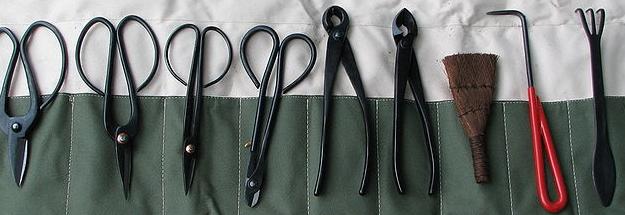

|
BONSAI |
|||
|
|
GETTING IT RIGHT Growing bonsais requires three things: you need to get the soil
right, proper watering is crucial, and you need a good eye. SOIL COMPOSITION For many years bonsai growers in the West couldn't understand how growers in the East achieved such great results. The secrete is in the soil. Getting the soil composition right is critical to watering your plants. Here's how you do it. You need two wooden frames. Nail 2x4s together to make a box. On the bottom of one frame nail soffit screen.
On the bottom of the other box nail regular window screen. Take the box with the soffit screen, and sift your dirt through it. You can't use anything that doesn't fall through the bottom. Use only the dirt that sifted through the screen. Next take the frame with the regular window screen, and resift the dirt. Anything that falls through that is too small. It will obstruct the flow of water - and cause root rot. Make sure you put your soil in a pot with adequate
drainage. I prefer to build my pots with wood molding. Put your molding
at an angle -
see picture here. Staple two sheets of pet resistant window
screen on the bottom. This is made of a fiber that won't rust. You need
little feet at the corners to allow air flow and drainage. Obviously
water will get all over the place, so you also need a special place to
water. PROPER WATERING This technique to watering should be applied to all plants. First scratch the surface with your finger. If you can feel moisture, do not water. Over watering, and stagnant water, causes root rot. If the soil is dry just under the surface, it is safe to water. Quickly and lightly sprits the surface of the soil with water. Leave the plant to soak up the water for about 15 minutes. The reason for this is to break the surface tension. You may have noticed that when you water, the water rushes down cracks, and beads up on the surface. That's happens because dry dirt tends to repel water. This is bad since your bonsai won't get enough to drink. Next water the plant, so water seeps out of the bottom of the pot, and leave your bonsai for about 20 to 30 minutes. Water again. This time the purpose of the watering is to leach the soil of toxins. You should do this each time. Put your ear to the soil; if you got the soil and drainage right, you should be able to hear the water whooshing through the pot. Unfortunately this step also flushes fertilizer out, so you need to fertilize frequently. Jobe plant spikes will take care of this problem.
Growing bonsais requires a good eye. You just have to recognize a tree, tree branch, or bush that looks like a bonsai. Small leaves are important to the illusion. We don't grow bonsais from seeds. We look for small trees that have been damaged. These are transplanted during the fall or early spring. Drastic cutting and sculpting are required with this method, but it produces the best bonsais. View the video link. Another way of creating bonsais is to just notice a tree branch that has the right look. This way is not as effective because it doesn't give you the large treelike trunk you want. Decide where you want your roots to be, and paint the area of the branch with a chemical that causes roots to grow in abnormal places. You purchase this chemical, or you can make it by boiling willow branches. Next pack peat moss around the area, and wrap it with a nylon stocking. Water it frequently, and put your rooting agent in your water. You can also look for bushes to use. During the fall or early spring reduce the root mass, and prune the bush to look like a bonsai. To bend a branch we wrap copper wire around it. Pinching a bud is all you need to do to stop a branch from growing in that direction.
|
||
Web Design by John Chiappone Designs